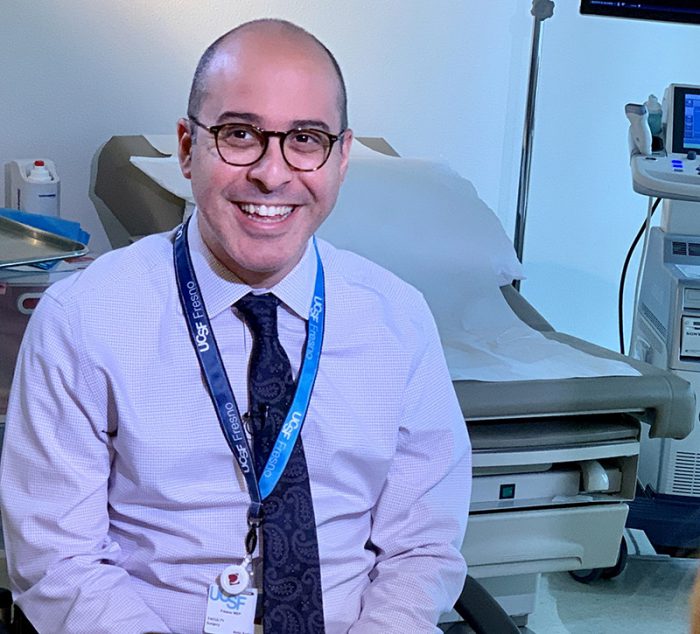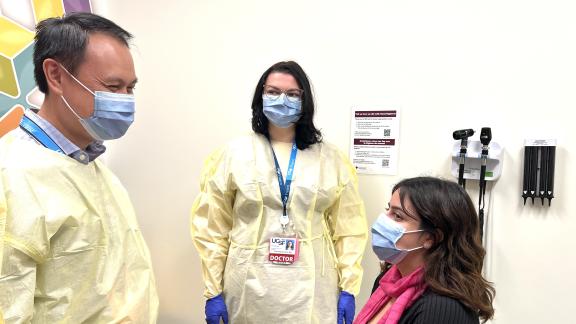The first time, the young man felt an intense pain in his belly, the sudden attack lasted for five minutes.
The next attack came as unexpectedly as the first, and disappeared as quickly.
The south San Joaquin Valley resident knew something was wrong, but examinations by doctors and blood work at the local hospital had found nothing out of the ordinary.
But on the third episode in February – four months after the first painful attack – the discomfort awakened him from sleep. “It would not go away,” he said.
A scan of his abdomen showed a cystic mass on his liver – and doctors knew by its appearance that parasites were inside. The young man had hydatid disease caused by infection with the larval stage of the dog tapeworm Echniococcus grandulosus.
 Very few cases of hydatid disease are reported in the United States, but there was no mistaking that the cyst was caused by the dog tapeworm, said UCSF Fresno’s Amir Fathi, MD, a liver surgeon. “This type of disease has a very classic appearance on axial imaging. So when you get at CT scan or an MRI, it is classic textbook and you see it and you know exactly what it is.”
Very few cases of hydatid disease are reported in the United States, but there was no mistaking that the cyst was caused by the dog tapeworm, said UCSF Fresno’s Amir Fathi, MD, a liver surgeon. “This type of disease has a very classic appearance on axial imaging. So when you get at CT scan or an MRI, it is classic textbook and you see it and you know exactly what it is.”
The parasitic disease most often affects the liver, but can affect the lung, spleen, kidney, bones and brain. People become infected when they accidentally swallow the eggs of the tapeworm. Dogs that eat home-slaughtered sheep and other livestock become infected with the tapeworm and the eggs can be found in their stool, according to the federal Centers for Disease Control and Prevention. People become infected from petting infected dogs and from ingestion of soil, water and vegetables that have been contaminated with infected dog feces.
The south Valley resident was familiar with the parasitic disease. Thirteen years ago when he was a child living in Yemen, he had an operation to remove parasites. Hydatid disease is common in populations raising sheep in Africa, Europe, Asia, the Middle East and Central and South America, the CDC says. He isn’t sure how he became infected but he remembers being around goats and sheep.
Tapeworm larvae can grow in the body for years before symptoms appear. Somehow during his operation in Yemen a decade ago, a few parasites escaped eradication. Now, he needed surgery again but safely removing the parasites would be tricky and require Dr. Fathi’s skills as a liver surgeon.
“This is such a rare disease with very bad ramifications of wrong treatment,” Dr. Fathi said.
Dr. Fathi assembled a multidisciplinary team that included Naiel N. Nassar, MD, program director of infectious disease at UCSF Fresno. “With Dr. Nassar’s help, we actually reached out to our counterparts in Egypt and Iran and asked for their experience about this disease,” Dr. Fathi said. “We had one shot with this guy to eradicate the disease and have the best possible outcome without any deleterious complications.”
The surgery required a carefully choreographed plan. Dr. Fathi first ordered a full body scan to make sure the parasites were isolated to the liver. “We looked everywhere else because this patient had had this since childhood,” he said. “And we had learned from our Iranian colleagues that if you have disease in the chest you have to treat the chest disease before the abdomen.”
The body scan showed three softball-size cysts – all in the liver. The team pre-treated the patient with an oral anti-parasite medication to kill as many of the parasites as possible. Two of the cysts were located near major veins and removing them could compromise the liver. Dr. Fathi injected the cysts with 99 percent alcohol and hypertonic saline to kill as many of the parasites as he could in the operating room, under a controlled setting.
He packed the liver, isolating the organ to prevent any parasites from escaping into the abdomen. “And then we very carefully opened the cysts where all the parasites lived and the parasites were removed.” Dr. Fathi said.
The team had to move quickly. As Dr. Fathi removed the parasites, the patient’s blood pressure plummeted – he was experiencing anaphylactic shock — but the physicians had prepared for the possibility and stabilized him.
An MRI after the surgery showed the parasites were gone. And a month after surgery, the young man had recovered enough to be released for work. He is grateful to Dr. Fathi. “He’s been with me since step one. He’s a really good doctor.”




